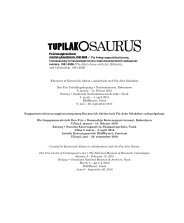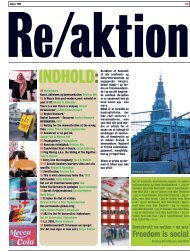tupilakosaurus - Print matters!
tupilakosaurus - Print matters!
tupilakosaurus - Print matters!
Create successful ePaper yourself
Turn your PDF publications into a flip-book with our unique Google optimized e-Paper software.
uttutut kamanneq. 1997<br />
sigiinngitsigisunik paasiniarneqarsinnaanera.<br />
Arke kingumut qiviarpoq takutillugillu<br />
arnat isikkorissut. Namminneq avatangiisiminni<br />
angutinut illissaarput. Angutip<br />
kajungernera takutippaat. Ilisimasaqarusunneq,<br />
pissaaneqarneq atoqatigiinnerlu. Angutip<br />
qarliimmi iluatigut tissarnera. Kajungerneq<br />
ima erseqqitsigisoq allaat ilisimatusarnerup<br />
atisallu ammit iluannut toqqortariaqarluni.<br />
Kisianni takuneqarsinnaalersarpoq arnat<br />
qanoq assilisinnerisigut: “The Mistress of the<br />
Tupik”, “Arctic Bronze” aamma “Flash-light<br />
Study”.<br />
Pearyp, Hensonip, Entrikinip imaluunniit<br />
Clarkip erfalasoq Qalasersuarmi kisimik nappanngilaat.<br />
Suliaat piviusunngunngisaannarsimassagaluarput<br />
nunaqavissunit, arnanit,<br />
ikiorneqarsimanngikkaluarunik. Arnap<br />
atisaliuuppai, nerisassiuuppai, aqqutissaannik<br />
ajoqersuuppai, ilami takornartat taakku<br />
issittup pissusivianik paasitippai. Naatsorsoruminaatsutut,<br />
tinnapaartutut nujuartatulluunniit<br />
inngilluinnarpoq. Kusanartuuvoq,<br />
ilisimasaqarluarluni kissalaartuullunilu.<br />
Issittumut ornigukkusunnermi pingaarutilik,<br />
puigorusutarli, atoqatigiinnermut tunngavoq.<br />
Peary avanersuarmiumik arnamik,<br />
taamani 14-iinnarnik ukiulimmik, ilaqartalerpoq.<br />
Tamanna Pearyp aningaasaliisuinit<br />
miserratigineqarpoq puigoqquneqarlunilu.<br />
Qalasersuarmut angalanerit aningaasalersorneqarnerisa<br />
tunngavigaat Pearyp minguissusia.<br />
Paatsiveerutitsisimassagaluarpormi,<br />
ajunaarnersuunngikkuni, inunni qernertunik<br />
qaqortunillu immikkoortitsisuni tamanna<br />
paasineqaraluarpat.<br />
Takusassarsiortut eskimuut arnartaannik<br />
aqqusaakkaminni naapitaminnit illigilikkaminnillu<br />
atoqateqartarnermikkut qassiunerinik<br />
ilisimaneqanngitsunik kinguaaqarput.<br />
Kisianni tamakku oqaluttuarisaanermi<br />
pilikkimik ersinngitsumik allanneqarput,<br />
assuarnarmata.<br />
Arke inunngorpoq assersuutitut taaneqartutut<br />
eskimuup arnap Pearyllu imminnut<br />
sammisimanerattut. Kalaallimik anaanaqarpoq<br />
qallunaamillu ataataqarluni. Alliartorpoq<br />
akuleriiaat, oqaluttuarisaanermik toqqorterisut<br />
allanngorartitsisullu, akornanni.<br />
Inuunini atorpaa paasineqarsinnaanngitsut<br />
allatallu akornanni allanneqanngitsut paasiniarnerinut<br />
uppernarsaatissarsiorluni. Issittumi<br />
silaarulluni kamannermi kiisami arnaq<br />
saqqummerpoq, aamma arnatut pissusimigut.<br />
Pissaanilik, patajaatsoq eqqissisimasorlu.<br />
Iben Mondrup<br />
Pia Arke. Arctic Hysteria. 1997<br />
In Pia Arke’s photo work Arctic<br />
Hysteria (sometimes also referred to<br />
as Arctic Hysteria IV) I first see that<br />
which is naked as opposed to that<br />
which is clad in skins and furs. Summer<br />
as opposed to winter, nature as<br />
opposed to science. It is in all respects<br />
opposites that meet in the prototypes<br />
of the male explorer and the female<br />
savage, 7 persons in all, whom Arke<br />
has drawn out of the yellowed pages<br />
of the polar explorer Robert E. Peary’s<br />
descriptions of his journeys.<br />
The next thing I see is the title of the<br />
work: Arctic Hysteria. Very dramatic,<br />
seen in relation to the peaceful poses<br />
of the people portrayed. The title<br />
points out of the work. Points to Arke’s<br />
life and the way in which it merged<br />
with the reality around the explorations<br />
of the early ethnographers’<br />
journeys in Arctic cultures.<br />
“Arctic hysteria” (piblokto) was a<br />
culturally related psychopathological<br />
phenomenon that Peary’s contemporaries<br />
diagnosed in the Eskimos.<br />
The condition, hysterical screaming<br />
followed by cramps and loss of<br />
self-control, was, it seemed, virtually<br />
psychotic. It appeared in winter and<br />
especially in women who suffered from<br />
vitamin poisoning – it was believed.<br />
That kind of hysteria was just one of<br />
the spectacular features that were observed<br />
in the polar regions. Together<br />
with other peculiarities it would come<br />
to constitute the science that was to<br />
explain the savages’ mental instability<br />
and legitimise the cultural superiority<br />
of the white race.<br />
There are photographs documenting<br />
“Arctic hysteria”. Driven by her curiosity<br />
about the ways in which photographs<br />
can generate history, Arke<br />
unearthed these pictures. One of them<br />
was a photo of a semi-naked woman<br />
being held by two men in front of the<br />
camera and screaming with fear.<br />
Arke was not given permission to use<br />
the specific picture in her work, probably<br />
because it was too compromising.<br />
It embodied the latent violation that<br />
also formed part of scientific investigations<br />
at that time. But Arke found<br />
her own ambiguous way of examining<br />
“Arctic hysteria”.<br />
Arke goes back and shows instead<br />
the women with their ample forms.<br />
In their element they make a show of<br />
themselves for the men. She shows<br />
male lust. For knowledge, power and<br />
sex. His erection under his clothes. A<br />
lust that was so pronounced that it<br />
had to be covered under science, skins<br />
and furs. But which appears in the<br />
way the women have been posed: “The<br />
Mistress of the Tupik”, “Arctic Bronze”<br />
and in “Flash-light Study”.<br />
Peary, Henson, Entrikin or Clark<br />
planted more than just their flags<br />
at the Pole. Their feats would never<br />
have been possible without massive<br />
assistance from the natives, from the<br />
women. They sewed clothes, made<br />
soup, showed the way and in general<br />
initiated the strangers into the reality<br />
of the Arctic. She was anything but<br />
unstable, insane or savage. She was<br />
beautiful, gifted and warm.<br />
An important but repressed part of<br />
the advances in the polar region was<br />
sexual. Peary had an Eskimo woman,<br />
who was only 14 years old at the<br />
beginning of their relationship. This<br />
was denied and suppressed by Peary’s<br />
supporters. The financing of the polar<br />
journeys was dependent on Peary‘s<br />
purity. Knowledge of the relationship<br />
would have caused confusion, would<br />
have been disastrous, in a conceptual<br />
world where black and white had to be<br />
kept separate.<br />
In return for sex, the adventurers left<br />
behind an unknown number of descendants;<br />
children they had with Eskimo<br />
women that they met and desired<br />
along the way, but who were recorded<br />
in history in invisible ink, because<br />
they were inappropriate.<br />
Arke was born out of the relationship<br />
between the symbolic Eskimo woman<br />
and Peary. She had a Greenlandic<br />
mother and a Danish father. She grew<br />
up in a bastardised world, between<br />
historical repression and historical displacement.<br />
She devoted her life to reassembling<br />
the documents, to making<br />
out what was unclear and to reading<br />
between the lines. In Arctic Hysteria<br />
we for once see women as they also<br />
were. Powerful, balanced, cool.<br />
Iben Mondrup<br />
27




